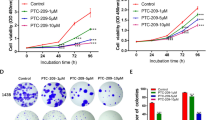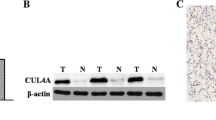Abstract
Background
Although osteosarcoma (OS) is the most common malignant bone tumor, the biological mechanism underlying its incidence and improvement remains unclear. This study investigated early diagnosis and treatment objectives using bioinformatics strategies and performed experimental verification.
Methods and results
The top 10 OS hub genes—CCNA2, CCNB1, AURKA, TRIP13, RFC4, DLGAP5, NDC80, CDC20, CDK1, and KIF20A—were screened using bioinformatics methods. TRIP13 was chosen for validation after reviewing literature. TRIP13 was shown to be substantially expressed in OS tissues and cells, according to Western blotting (WB) and quantitative real-time polymerase chain reaction data. Subsequently, TRIP13 knockdown enhanced apoptosis and decreased proliferation, migration, and invasion in U2OS cells, as validated by the cell counting kit-8 test, Hoechst 33,258 staining, wound healing assay, and WB. In addition, the levels of p-PI3K/PI3K and p-AKT/AKT in U2OS cells markedly decreased after TRIP13 knockdown. Culturing U2OS cells, in which TRIP13 expression was downregulated, in a medium supplemented with a PI3K/AKT inhibitor further reduced their proliferation, migration, and invasion and increased their apoptosis.
Conclusions
TRIP13 knockdown reduced U2OS cell proliferation, migration, and invasion via a possible mechanism involving the PI3K/AKT signaling pathway.





Similar content being viewed by others
Data Availability
The data used to support the findings of this study are available from the corresponding author upon request.
Code Availability
Not applicable.
References
Carina V, Costa V, Sartori M et al (2019) Adjuvant biophysical therapies in osteosarcoma. Cancers (Basel) 11(3):348
Harrison DJ, Geller DS, Gill JD et al (2018) Current and future therapeutic approaches for osteosarcoma. Expert Rev Anticancer Ther 1:39–50
Zhang J, Yan YG, Wang C et al (2015) MicroRNAs in osteosarcoma. Clin Chim Acta 9:17
Luetke A, Meyers PA, Lewis I et al (2014) Osteosarcoma treatment - where do we stand? A state of the art review. Cancer Treat Rev 4:523–532
Defachelles L, Russo AE, Nelson CR et al (2020) The conserved AAA-ATPase PCH-2 (TRIP13) regulates spindle checkpoint strength. Mol Biol Cell 20:2219–2233
Lu S, Qian J, Guo M et al (2019) Insights into a crucial role of TRIP13 in human cancer. Comput Struct Biotechnol J 17:854–861
Li ZH, Lei L, Fei LR et al (2021) TRIP13 promotes the proliferation and invasion of lung cancer cells via the Wnt signaling pathway and epithelial-mesenchymal transition. J Mol Histol 1:11–20
Lu S, Guo M, Fan Z et al (2019) Elevated TRIP13 drives cell proliferation and drug resistance in bladder cancer. Am J Transl Res 7:4397–4410
Zhou Y, Zhou B, Pache L et al (2019) Metascape provides a biologist-oriented resource for the analysis of systems-level datasets. Nat Commun 1:1523
Pagano A, Breuzard G, Parat F et al (2021) Tau regulates glioblastoma progression, 3D cell organization, growth and migration via the PI3K-AKT axis. Cancers (Basel) 22:5818
Jaffe N (2009) Osteosarcoma: review of the past, impact on the future. The American experience. Cancer Treat Res 2009:239–262
Zhang J, Li N, Lu S et al (2021) The role of Notch ligand Jagged1 in osteosarcoma proliferation, metastasis, and recurrence. J Orthop Surg Res 1:226
Chen R, Huang LH, Gao YY et al (2019) Identification of differentially expressed genes in MG63 osteosarcoma cells with drug–resistance by microarray analysis. Mol Med Rep 3:1571–1580
Liu Y, Xi Y, Chen G et al (2020) URG4 mediates cell proliferation and cell cycle in osteosarcoma via GSK3β/β-catenin/cyclin D1 signaling pathway. J Orthop Surg Res 1:226
Watkins TBK, Lim EL, Petkovic M et al (2020) Pervasive chromosomal instability and karyotype order in tumour evolution. Nature 7832:126–132
Ferreira de Oliveira JMP, Almeida JFD, Martins M et al (2021) 3’,4’-Dihydroxyflavonol modulates the cell cycle in cancer cells: implication as a potential combination drug in osteosarcoma. Pharmaceuticals (Basel) 14(7):640
Gupta D, Silva M, Radziun K et al (2020) Fucoidan inhibition of osteosarcoma cells is species and molecular weight dependent. Mar Drugs 18(2):104
Zhang G, Zhu Q, Fu G et al (2019) TRIP13 promotes the cell proliferation, migration and invasion of glioblastoma through the FBXW7/c-MYC axis. Br J Cancer 12:1069–1078
Zhou XY, Shu XM (2019) TRIP13 promotes proliferation and invasion of epithelial ovarian cancer cells through Notch signaling pathway. Eur Rev Med Pharmacol Sci 2:522–529
Pastushenko I, Blanpain C (2019) EMT Transition States during Tumor Progression and Metastasis. Trends Cell Biol 3:212–226
Saitoh M (2018) Involvement of partial EMT in cancer progression. J Biochem 4:257–264
Dong L, Ding H, Li Y et al (2019) TRIP13 is a predictor for poor prognosis and regulates cell proliferation, migration and invasion in prostate cancer. Int J Biol Macromol 121:200–206
Xu W, Yang Z, Lu N (2015) A new role for the PI3K/Akt signaling pathway in the epithelial-mesenchymal transition. Cell Adh Migr 4:317–324
Yang Q, Jiang W, Hou P (2019) Emerging role of PI3K/AKT in tumor-related epigenetic regulation. Semin Cancer Biol 59:112–124
Wei R, Xiao Y, Song Y et al (2019) FAT4 regulates the EMT and autophagy in colorectal cancer cells in part via the PI3K-AKT signaling axis. J Exp Clin Cancer Res 1:112
Xu E, Xia X, Jiang C et al (2020) GPER1 silencing suppresses the proliferation, migration, and invasion of gastric cancer cells by inhibiting PI3K/AKT-Mediated EMT. Front Cell Dev Biol 8:591239
Kiaris H, Chatzistamou I, Papavassiliou AG et al (2011) Growth hormone-releasing hormone: not only a neurohormone. Trends Endocrinol Metab 8:311–317
Fanelli M, Tavanti E, Patrizio MP et al (2020) Cisplatin resistance in osteosarcoma: in vitro validation of candidate DNA repair-related therapeutic targets and drugs for tailored treatments. Front Oncol 10:331
Wu X, Yu H, Zhou H et al (2020) Proanthocyanidin B2 inhibits proliferation and induces apoptosis of osteosarcoma cells by suppressing the PI3K/AKT pathway. J Cell Mol Med 20:11960–11971
Aziz MNM, Rahim NFC, Hussin Y et al (2021) Anti-metastatic and anti-angiogenic effects of curcumin analog DK1 on human osteosarcoma cells in vitro. Pharmaceuticals (Basel) 14(6):532
Zhu MX, Wei CY, Zhang PF et al (2019) Elevated TRIP13 drives the AKT/mTOR pathway to induce the progression of hepatocellular carcinoma via interacting with ACTN4. J Exp Clin Cancer Res 1:409
Acknowledgements
Not applicable.
Funding
Funding was provided by the Science and Technology Bureau of Lanzhou (Grant No. 2018-3-79).
Author information
Authors and Affiliations
Contributions
Y-DC, C-XY and Z-HY conceived and designed the idea to this paper; L-MQ, G-XD, G-TW, ZK, Z-XB, Z-RH and H-YC participated in its design and coordination and supervised the study. Y-DC, Y-DQ and Y-XL analyzed the data and revised the final paper. All authors read and approved the final version of the manuscript. Y-DC was the first author of this article, Y-DC and C-XY contributed equally to this work.
Corresponding author
Ethics declarations
Conflict of interest
The authors declare no competing interests.
Ethical approval
Our study was approved by the ethics committee of the Second Hospital of Lanzhou University (Project Number: 2021 A-407).
Consent to participate
Informed consent was obtained from all individual participants included in the study.
Consent for publication
The authors affirm that human research participants provided informed consent for publication of the images in Fig. 4a and c.
Additional information
Publisher’s Note
Springer Nature remains neutral with regard to jurisdictional claims in published maps and institutional affiliations.
Rights and permissions
About this article
Cite this article
Yu, DC., Chen, XY., Zhou, HY. et al. TRIP13 knockdown inhibits the proliferation, migration, invasion, and promotes apoptosis by suppressing PI3K/AKT signaling pathway in U2OS cells. Mol Biol Rep 49, 3055–3064 (2022). https://doi.org/10.1007/s11033-022-07133-6
Received:
Accepted:
Published:
Issue Date:
DOI: https://doi.org/10.1007/s11033-022-07133-6




